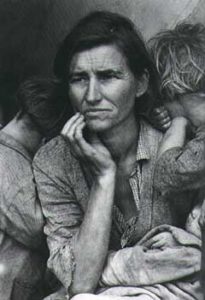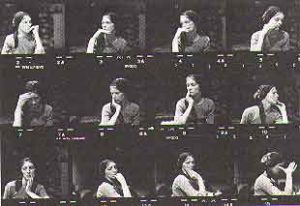Family gesture: Nancy Kitchel provides a relay for how to locate mood or atmosphere in a local and family setting.
“Covering My Face: My Grandmother’s Gestures,” 1973
How a particular Midwestern storytelling tradition resembles the landscape. How my aunt or my mother can tell a story in such a way that the peaks (of violence) are cut off and the low points are filled up (with details, with emphasis), until the whole is perfectly flat and contains the violence.
This family gesture may be linked with the iconic gestures found in religious art and contemporary entertainment media.
Gestures and Icons. Migrant Mother, Nipomo, California, Dorothea Lange, 1936
 Nancy Kitchel’s “grandmother’s gesture” may be seen as a series of variations on a gesture of worry and anxiety codified in this photograph taken by Dorothea Lange as part of a New Deal project to document the misery of migrant workers, sponsored by the Farm Security Administration during the Great Depression. “Migrant Mother” is one of the most-cited pictorial images of our times.
Nancy Kitchel’s “grandmother’s gesture” may be seen as a series of variations on a gesture of worry and anxiety codified in this photograph taken by Dorothea Lange as part of a New Deal project to document the misery of migrant workers, sponsored by the Farm Security Administration during the Great Depression. “Migrant Mother” is one of the most-cited pictorial images of our times.
A repetition of gestures of this sort opens a conductive inference path between (in this case) Family and History. If Kitchel were doing our assignment this gesture would justify a search in documentation of “the Great Depression” to find a metaphor to express the mood of her Family circumstances.
–Landscape Gest (Outer Scene = State of Mind). Kitchel provides another example of Existential Disaster (cosmic glimpse), inclulding visionary Whiteness.
“Last White (Interior Landscape)”, 1975
This idea I have that the whole inside of my head resembles this landscape (flat? nothing there?), that the particular, peculiar sense of great space, isolation in space, harshness, clarity, severity, the constant transitions, shifts, reveries, the wild swings form one state to another, forms the visual, auditory, reasoning, base for thought or action. A sense that I have been formed out of the quality of the landscape, that everything unnecessary is being slowly eroded by harsher elements. And the confidence that I will survive, denuded, or that something will survive, something will never stop.”
Nancy Wilson Kitchel, “Visible and Invisible” Individuals: Post-Movement Art in America
Ed. Alan Sondheim


Leave A Comment
You must be logged in to post a comment.